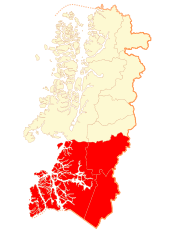Capitán Prat Province
| Capitán Prat Province Provincia de Capitán Prat | ||
|---|---|---|
| Province | ||
| ||
 Location in the Aysén del General Carlos Ibáñez del Campo Region | ||
 Capitán Prat Province Location in Chile | ||
| Coordinates: 48°00′S 73°25′W / 48.000°S 73.417°WCoordinates: 48°00′S 73°25′W / 48.000°S 73.417°W | ||
| Country | Chile | |
| Region | Aisén | |
| Named for | Arturo Prat | |
| Capital | Cochrane | |
| Communes |
Cochrane O'Higgins Tortel | |
| Government | ||
| • Type | Provincial | |
| Area[1] | ||
| • Total | 37,043.6 km2 (14,302.6 sq mi) | |
| Population (2012 Census)[1] | ||
| • Total | 4,003 | |
| • Density | 0.11/km2 (0.28/sq mi) | |
| • Urban | 2,217 | |
| • Rural | 1,620 | |
| Sex[1] | ||
| • Men | 2,154 | |
| • Women | 1,683 | |
| Time zone | CLT [2] (UTC-4) | |
| • Summer (DST) | CLST [3] (UTC-3) | |
| Area code(s) | 56 + 67 | |
| Website | Government of Capitán Prat | |
Capitán Prat Province (Spanish: Provincia de Capitán Prat) is one of four provinces in the southern Chilean region of Aisén (XI). Its capital is Cochrane. The province is named after the naval hero Arturo Prat.
Geography and demography
It is Chile's eighth largest and fourth least populated province as well as the most sparsely populated province in continental Chile. According to the 2002 census by the National Statistics Institute (INE), the province spans an area of 37,043.6 km2 (14,303 sq mi) and had a population of 3,837 inhabitants (2,154 men and 1,683 women), giving it a population density of 0.10 per km2 (0.3 per m2). At that time, 2,217 (57.8%) lived in urban areas and 1,620 (42.2%) in rural areas. Between the 1992 and 2002 censuses, the population grew by 1.5% (56 persons).[1]
Administration
As a province, Capitán Prat is a second-level administrative division, governed by a provincial governor appointed by the president. The province comprises three communes, each governed by a municipality, headed by an alcalde: Cochrane, O'Higgins and Tortel.
See also
References
- 1 2 3 4 "Territorial division of Chile" (PDF) (in Spanish). National Statistics Institute. 2007. Retrieved 18 March 2011.
- ↑ "Chile Time". WorldTimeZones.org. Retrieved 2010-07-28.
- ↑ "Chile Summer Time". WorldTimeZones.org. Archived from the original on 2007-09-11. Retrieved 2010-07-28.

